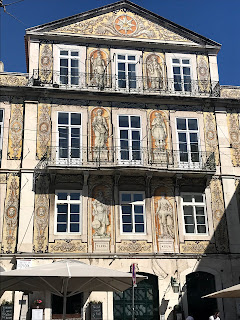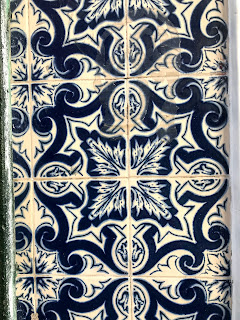It’s been about a week since we finished our 900km walk across Spain. I thought it might be time to reflect on what it was all about. I’ll write from my perspective, as Sue may want to write later from hers.
The Camino de Santiago is at its core a religious pilgrimage, with the destination the Cathedral in Santiago de Compostella where the bones of St James are said lie. The journey does not have to be religious. Many people do it for fun or sport or adventure.
We first came to know the Camino, like many Americans, from the movie The Way. I thought it sounded fun, and different, and wanted to say that I had actually walked all the way across the north of Spain. It was adventure calling. It took over four years to arrange our schedules to be able to be away for 40 some days. Special thanks to everyone who helped make that possible.
I also had a desire to see where the spiritual/religious side of the Camino might take me. There was a vague idea of things I wanted to discover or work through, but nothing really defined. I was hoping the journey might bring these things into focus.
We started on April 8th very excited, but very naive. It was cold and rainy, but up the mountains we climbed through the mud. All our posessions for the next 40 days we carried on our backs. Every day was great, even the couple of really bad ones.
We met fellow pilgrims starting at the bus station in Pomplona, and met more everyday thereafter. People from all over the world. The conversation always began with, “where are you from?”, and often moved to, “so why are you doing the Camino?”
We got to hear and learn lots. The common goal of reaching Santiago, combined with the physical demands of the hike and the openness to share stories made for instant bonding. And we heard some powerful and inspiring stories. A German woman whose best friend had died with a last unfulfilled wish to do the Camino. Two heart bypass survivors. A woman dying from Leukemia. A wealthy man in his 70’s who said he was getting more religious as he got older and wanted to gain perspective. The Iowan who first heard about the Camino at age 8 in Life magazine, now 50 yrs later, he has a serious asthma condition where his doctor advised against the trip due to possible death. He had to carry a 20lb machine with him. His friends offered to help carry, but no; this was his burden to carry. The young woman who said she didn’t want to go home because there she was a failure if she wasn’t married and didn’t have children. The man who was terrified because he was retiring in 23 days and did not know what to do. There are probably 50 or 100 more.
So, as I began and heard these stories, I couldn’t help to instantly feel for these people and ooze empathy. I just wanted to share their pain and do anything I could to lighten their burden.
Then my thoughts started turning inward. But I didn’t have a story like those to share. What was my purpose?
During the next two weeks I spent a lot of time thinking about people I knew who had passed away. I kept thinking of regrets. And did I have time to think. We walked from about 7:15am to about 4:00, everyday. We walked together, but mostly in silence.
Regrets and forgiveness, that’s where my mind kept going. Maybe that was my Camino purpose. It became sad and intense. And new stories kept coming as we met new pilgrims each day. And I kept remembering things from the past that I regretted.
I finally accepted that my reason for doing the Camino was to think about life and death. What it means, how I miss those who passed, what my legacy will be, and how best to spent my remaining time. Not original ideas of course, not really specific, but still personal and intimate. It wasn’t until the night with the singing nuns that I actually said that this was my purpose out loud.
Then after about two weeks my thoughts started to change. The sadness began to lift. I now started to listen to pilgrim stories from a different perspective. Now I could listen to them, relate to the person, but I no longer had a need to empathize. I no longer felt the need to try to assume and ease their burden. Their Camino was theirs. It was not mine. I could listen and understand with just humility and respect. This was a break through. Maybe this was my Camino moment. This brought my search to understand life and death into a new perspective. Respect and accept.
We actively sought out religious interactions along the way, and we are glad that we did. We fondly remember the pilgrim masses and pilgrim blessings we attended, staying in monasteries when possible, stopping at all the old churches that we could, and of course our arrival in Santiago to pay our respects to St James. All these things made the journey all the more richer.
We were a little surprised that there were not more of these types of things along the way. But times change. Many, many old churches are closed or abandoned. There have not been Knights Templar for 600 yrs. When we did see nuns they were almost always very, very old. Many could barely walk. At the largest monastery in Spain (2nd largest in Europe) the entire enormous complex was staffed with only 4 monks, one of whom was 92 yrs old. Many old monasteries have been converted to luxury hotels.
About half way thru the journey we stayed at a monastery. The priest who checked us in invited us to a pilgrim mass that night. We accepted that invitation and are so glad we did. He also invited us to join them after mass for bread and soup and sharing. That invitation we declined because we wanted to walk around the town a bit, and we really weren’t sure about the soup and bread and sharing. And, we figured there would be lots of other opportunities later.
I am sorry we didn’t go. The German woman who was our roommate that night did attend and she said it was wonderful. We never got another opportunity. What I remember most was the blessing that the priest gave us pilgrims after the mass. He said that everyone was wishing and praying for us to have a successful pilgrimage on our journey to Santiago. That our burdens are lifted and that we arrive safely and peacefully at our destination. Then he continued. But that is not the end. That we are to use the Camino as a metaphor in our lives to continue our journeys to our true final destination, and that our burdens are lifted and that we arrive there safely and peacefully as well. As simple as that though is I received it as profound. Maybe that is my lesson of the Camino.
One final memory. About theee weeks into the journey I had a truly wonderful dream. It was me, my sister Julie, and our dad. Just us three. We were all adults. We were in some city in the US walking thru an area with lots of shops and cafes. It was a beautiful sunny day. Dad was completely healthy, both body and mind. We just walked, and sat, and walked some more. There was no rush, we had all the time in the world. We didn’t need to talk much. There was nothing that needed to be said. We just spent that wonderful afternoon together. It was the most pleasant dream I have ever had, and I will always remember it. In many ways just having that one dream made walking 900km all worth while.


















































